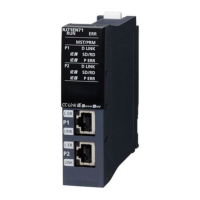5 FUNCTIONS USED WITH SSCNET COMMUNICATION
5.7 Connection of Sensing Module
241
5
■Example
An example for mark detection using the external input signal (DI1) of the sensing I/O module (RIO axis No. 601) is shown
below.
1. Set the servo parameters as follows.
2. Set the high-speed input request signal settings as follows.
3. Set the number of the high-speed input request signal set in "2." to the "High-speed input request signal" of mark
detection.
4. Turn ON/OFF the external input signal (DI1) of the sensing I/O module (RIO axis No. 601).
• When operation mode is "Axis mode", the timing-latch input function cannot be used.
• For sensing SSCNET/H head module+sensing extension module, the input signals compatible with the
timing-latch input of sensing SSCNET/H head module are "DI1 to DI4".
Output CLEAR/HOLD function
When a failure occurs in communication with the Motion CPU, or the Motion CPU operation has been stopped by an error,
with the sensing module, set whether to hold the output state of the external output signal DO immediately before, or clear.
■Output CLEAR/HOLD function settings
For the Output CLEAR/HOLD function set the following servo parameters.
Refer to the following for details of servo parameters.
Sensing Module Instruction Manual
• Using sensing SSCNET/H head module
Servo parameter Setting value
DI1(CN1-10) setting 2 (PTB002) Function selection 1: Timing-latch input
DI signal edge selection 0: Rising edge, or 1: Falling edge
Item Setting value
Signal type 3: Sensing module input
Input module 2: MR-MT2100
Axis No. 601
Input signal 1: DI1
Parameter No. Item Setting value Setting details
PTA027 DO1(CN2-20) setting 1 Operation selection
at disconnection of
communication
0: CLEAR
1: HOLD
Sets the output state of the DO signal at disconnection
of communication.
PTA029 DO2(CN2-8) setting 1

